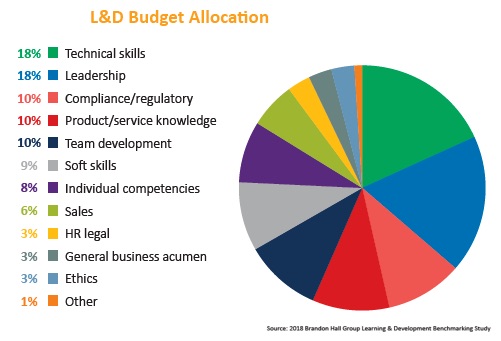Currently, things have never been more challenging for Learning and Development (L&D). The learning technology landscape has exploded with myriad new tools, applications, and platforms designed to improve the learner experience. At the same time, organizations are looking to L&D to guide them through their digital transformations, ensuring the workforce has the skills and knowledge required to survive and succeed.
For the last several years, fewer than 25 percent of companies expected their L&D budget to increase. Heading into this year, however, we find that one-third of companies expect a budget increase, signaling a bit of hope that organizations recognize the realities of the modern L&D environment. However, with more spending comes an increased focus on ROI.
Organizational leaders want to know what they are getting for their money, and L&D leaders traditionally have had a hard time demonstrating that. It is critical that companies make the most of their available dollars and create a learning environment that drives results. Brandon Hall Group’s 2018-2019 L&D Benchmarking Study found two areas where companies may want to focus on as they create their L&D budgets.
Too Much Spending at the Top?
It has always been critical for companies to develop a strong leadership pipeline to ensure the organization’s future survival and success. To that end, they spend a significant chunk of their L&D budgets on leadership development. In fact, leadership development takes up one of the biggest percentages of the budget, second only to technical skills development.

What do companies get for their top-heavy L&D spending? Moderate results at best. Brandon Hall Group’s Leadership Development Study found that 41 percent of companies do not believe their current leaders, as a group, have the competencies and emotional intelligence to successfully manage the organization’s business goals over the next 12 to 18 months. When asked why, there are many developmental challenges, but the idea that they are not spending enough is at the bottom of the list.
Modernizing the Learner Experience
Even in the midst of a digital transformation frenzy, the traditional instructor-led classroom remains the primary way companies deliver learning, used by approximately 94 percent of companies. E-learning modules are next, used by 77 percent of companies. There is nothing inherently wrong with instructor-led training (ILT) or e-learning—far from it. However, for companies trying to create a continuous learning culture, where learning is closely aligned with performance and the moment of need, there must be other options. Slowly but surely, companies recognize this and those with better key performance indicator (KPI) performance seem to be making the transition faster.
High-performing organizations (HiPOs) currently are doing more with mobile and collaborative learning and are more likely to do even more in the future. This indicates that HiPOs seek to make learning more accessible to their workforce, allowing them to discover learning opportunities and interact with them when and how they want.
The Future of the Learning Function
While not a direct expenditure in the budget, the way the Learning function is structured can have a huge impact on how that budget is allocated. Overall, we see more hybrid structures than fully decentralized or centralized learning organizations. However, HiPOs are far more likely to favor this configuration.
How we deliver learning is fundamentally changing. The mix of technologies and modalities has never been as broad and complex. Organizations must take a hard look at their learning strategy and what will be successful. Without proper budget considerations, however, the strategy can never become reality. The good news is that new approaches to learning are far more focused on results and outcomes than on enrollments and completions. This will arm L&D with the business impact required to get more budget to work with.
To download a free copy of Brandon Hall Group’s recent research summary, “Rethinking the Learning & Development Budget,” click here.
David Wentworth is principal learning analyst at Brandon Hall Group. The firm’s vision is to inspire a better workplace experience, and its mission is to empower excellence in organizations around the world through its research and tools. Brandon Hall Group has five HCM practices and produces the Brandon Hall Group HCM Excellence Awards and Excellence in Technology Awards; Women In Leadership Summit 2019, May 1-2, 2019; and the annual HCM Excellence Conference, in West Palm Beach, FL, February 4 -6, 2020.




